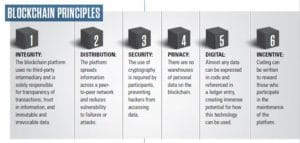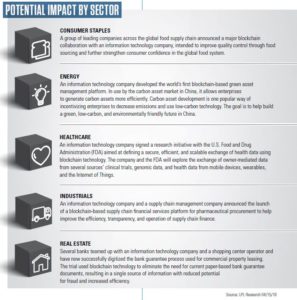
BLOCKCHAIN TECHNOLOGY is hailed by many as the next generation of the internet, or Internet 2.0. The technology is rapidly evolving, with the possibility of far-reaching implications across many sectors and industries. This evolution is forcing business leaders and strategists in every industry to investigate the possible applications of this disruptive technology, or risk being blindsided by competition that successfully adapts. Global digitalization through the development of the internet has changed the way we live our lives. The internet began with the sharing of information between two localized computers and has evolved to include email, the World Wide Web (“Web”), the mobile Web, social media, cloud computing, big data, and now voice-activated virtual assistants (e.g., Alexa) that sit in kitchens and living rooms across the globe. Digitalization has been instrumental in increasing the exchange of information, creating and storing information, and reducing costs. It has also lowered barriers to entry for businesses and spawned entirely new industries.
± THE PROBLEM: EXCHANGING INFORMATION
Further advancement of the digital exchange of information and value is inevitable and natural. Today, when exchanging information digitally, the internet requires an intermediary, incurring friction in the form of costs, delays, and risks. For example, if you want to send money to a friend or loved one, you use a service like PayPal or Western Union to complete that transaction on your behalf. To send an email, you log in to your email provider, create a message, and rely on that provider to successfully deliver your message. In these situations, this third-party validation solves the ‘lack of trust’ problem (i.e., honesty, consideration, accountability, and transparency) and gives clients confidence that the company is accurately completing the transactions. However, it also results in the centralization of data and the potential for two other dilemmas—breach of privacy and security. During the third-party validation process, central databases collect and store confidential data about individuals and institutions, sometimes without permission. Exchanging and storing information digitallycan lead to security issues where hacking, identity theft, fraud, phishing, spam, malware, and ransomware may occur. Several companies across many industries have suffered data breaches, including large retailers, consumer credit agencies, municipalities, financial institutions, and social media franchises, among many others.
± THE SOLUTION: BLOCKCHAIN
The initial use of blockchain technology can be traced back to 2008, when a new protocol was written for a peer-to-peer electronic cash system called Bitcoin1. Bitcoin is a cryptocurrency, which is a digital currency not tied to or backed by any government or country. Blockchain technology was critical, as it created a peer-to-peer network that allowed users to buy and sell Bitcoin through a transparent and secure digital ledger without an intermediary. Though sometimes confused, Bitcoin is not blockchain. While cryptocurrency may rely on blockchain technology, this is just one of many examples of the vast potential this intermediary free, distributed ledger could have.
± HOW BLOCKCHAIN WORKS
The blockchain process begins with data grouped together and recorded into files called blocks. Each block receives a timestamp so that it can be organized into a linear sequence, and each block must also contain a reference to the prior block to be added to the linear sequence, creating a chain of data. Every time new transactions occur or data is created, the process repeats to expand upon the existing chain of blocks. To keep the system running, anonymous peers on the network who receive financial incentives for solving mathematical equations and recording transactions collaboratively maintain the blockchain. Thus, the blockchain is essentially a record, or digital ledger, that is distributed and maintained by many different parties and can only be updated by a consensus of the parties. This consensus requirement ensures that once information is entered, it can never be erased or adjusted. It has been 10 years since the creation of blockchain technology. At first, this technology remained relatively unknown, confined within a core group of followers. Several years later, recognition spread as businesses and entrepreneurs began to understand its potential, as the decentralized nature of blockchain offers significant advantages compared to traditional methods of accounting and record keeping. Companies soon began experimenting with this technology outside of the world of digital currencies. For example, in 2015 the NASDAQ Stock Exchange piloted a blockchain-based solution to revolutionize the way shares are transferred and sold. Companies have also been banding together to collaborate on the development of the technology and its potential uses, as well as setting appropriate industry standards for its implementation.2 Many businesses have followed suit, eager to uncover new ways to leverage the principles that drive this transformative technology.

± THE APPLICATION OF BLOCKCHAIN: POTENTIAL FOR GROWTH
Bockchain’s key principles illustrate the potential for innovation through the implementation of blockchain technology across nearly every industry. The following use cases demonstrate the growing application of blockchain technology across various sectors.
INFORMATION TECHNOLOGY
■ Several information technology companies have offered blockchain-based solutions for intellectual property management, notary, and copyright services.
FINANCIAL SERVICES
■ An information technology company announced a new blockchain banking solution that will help financial institutions address cross-border payments, designed to reduce the settlement time and lower the cost of completing global payments.
■ Several banks entered a joint initiative launched by a bank and an information technology company to build a new global trade platform based on blockchain technology. This new platform is designed to be openly accessed by organizations of all sizes anywhere in the world and can support trade finance for transactions across all modes of trade, whether goods are being transported by air, land, or sea.
■ A European exchange and an information technology company announced they are building a blockchain solution to digitize the issuance of securities for small and medium enterprises in Europe. Designed to simplify the tracking and management of shareholding information, the new system intends to create a distributed, shared registry containing a record of all shareholder transactions, helping to open up new opportunities for trading and investing.
While the financial services and information technology industry have taken the lead on the implementation of blockchain technology, many other industries have been impacted as well.
± THE INVESTIBLE OPPORTUNITY
Ray Tomlinson is credited with inventing email technology in 1971. Like any new technology, it took several years for additional infrastructure like software and commercial packages to be created. Fast forward even further to 1990, when Tim Berners-Lee submitted the proposal to create the World Wide Web. When people think about the internet, many remember 1994–2000, when the internet experienced massive growth the likes of which had never been seen before. The uses of this technology have continued to expand even further, redefining the way many societies function. Despite their potential, it took 23 years for transformative technologies like email and the Web to reach the mainstream and provide investors with a plethora of investment opportunities.

According to Moore’s Law, growth in computing power is exponential but not indefinite. This tells us that we likely will not have to wait 23 years for blockchain technology to reach the mainstream investor. However, it’s important to remember that the technology, in its current state, possesses an abundance of untapped potential. Blockchain technology has the ability, through the decentralization of information, to ensure trust in transactions, reduce vulnerability to failures or security breaches, eliminate warehousing of personal data, and guarantee immutable and irrevocable data. Given the disruptive nature of blockchain technology and its vast potential across many sectors and industries, investment firms continue to investigate and launch new products to capitalize on this opportunity. Understanding that this technology is still in its infancy, but possesses the potential to be Internet 2.0, investors will need to approach the space with patience and prudence. Over time, as the technology continues to be developed and implemented across industries, we may see a multitude of investment options surface.
± UNVEILING A NEW PORTFOLIO
In response, LPL Research has launched the Blockchain Innovators Portfolio, available as a separately managed account (SMA). The objective of the portfolio is to provide exposure to the blockchain ecosystem— companies seeking to apply innovative blockchain technology as a way to increase operational efficiency and develop new business models. Using a rules-based approach, the portfolio will invest in companies involved in collaborating on blockchain technology, including setting standards, developing infrastructure, and executing transactions. As the technology continues to be developed and implemented, these companies should be the primary beneficiaries of increased operational efficiency and innovative problem-solving solutions.
Thank you to LPL Research for preparing this report.
1 Nakamoto, S. bitcoin.org. (2008) Bitcoin: a peer-to-peer electronic cash system
2 NASDAQ. (2015, December 30). NASDAQ LINQ enables first-ever private securities issuance documented with blockchain technology [Press release].
The opinions voiced in this material are for general information only and are not intended to provide specific advice or recommendations for any individual. To determine which investment(s) may be appropriate for you, consult your financial advisor prior to investing.
To the extent you are receiving investment advice from a separately registered independent investment advisor, please note that LPL Financial is not an affiliate of and makes no representation with respect to such entity.
Any economic forecasts set forth in the presentation may not develop as predicted and there can be guarantee that strategies promoted will be successful.
All company names noted herein are for educational purposes only and not an indication of trading intent or a solicitation of their products or services. LPL Financial doesn’t provide research on individual equities. Investing involves risks including possible loss of principal. No investment strategy or risk management technique can guarantee return or eliminate risk
in all markets.
Tracking #1-726875
